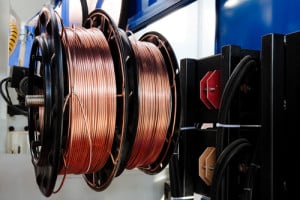
The tiniest imperfection in a piece of copper wire can render it useless. To prevent such manufacturing errors, Schwering & Hasse hooked up sensors to its production facility and implemented a real-time stream processing system that allowed a high degree of situational awareness. Schwering is now the only manufacturer that can spot problems in copper wire production before flaws develop.
Name of Organization: Schwering & Hasse
Industry: Manufacturing
Location: Lügde, Germany
Business Opportunity or Challenge Encountered
Schwering & Hasse (S&H) manufactures copper wire that goes into electronics parts, automobiles, and power tools. Due to the sensitivity of the parts and instruments that rely on S&H, quality management and stable production processes are essential.
The production of enameled copper wire is complex. The tolerances required for the insulation are minute, with even a tiny deviation from the specification rendering the wire useless. S&H, which works with leading companies such as Siemens, Bosche, and Continental, understands that one quality lapse can jeopardize the entire vendor relationship.
The company, which runs 400 production lines 24 hours a day, running enough magnetized copper wire each year to stretch beyond Venus, sought to build a “transparent” factory that enables immediate and accurate visibility into its complex production lines using streaming analytics. The company needed to be able to respond rapidly to head off potential problems, as well as achieve uninterrupted and flawless production of 140,000 kilometers of copper magnet wire a day.
However, the company’s existing information systems were not equipped to create a factory that was truly “transparent” to both line workers and managers. S&H had been using a system that was neither detailed enough to be aware of every phase in the production process nor capable of providing information in real time.
How This Business Opportunity or Challenge Was Met
S&H moved to support all its essential business processes—from the customer order to production and finally to delivery—through a more integrated and real-time IT infrastructure. On each production line process, test data is recorded. The non-destructive high-voltage testing device—developed by S&H in-house—provides ongoing test data on the manufactured product and is a central part of the production data acquisition system.
This gave S&H the ability to monitor dozens of independent quality factors in real time and process them against relevant production data. The company implemented a real-time event-processing engine, Software AG’s Apama Streaming Analytics, to inform decision-makers and production managers of specific machines, copper lots, workers and production parameters such as temperature—all in the context of historical manufacturing data. The system handles up to 50,000 production events per second.
S&H developers created factory-floor-level interfaces using screens that line workers could use to monitor quality and input data of their own.
Measurable/Quantifiable and “Soft” Benefits from This Initiative
With real-time quality control, S&H is now the only enameled copper wire manufacturer in the world that is able to record quality-relevant parameters on each individual production line in real time, evaluate them and take corrective measures when intervention limits are reached—i.e. before deviations actually occur from the promised specification. With its IT-enabled control system, the company is able to ensure that even the smallest faults in the cycle—materials, human factors, machine—are detected and addressed quickly.
Based on a fully-integrated IT system, the recording of operational data, production control and quality control all interact, enabling S&H to control more accurately and in a more targeted manner the quality of the wire, and meet the most demanding customer requirements regarding specifications, such as wire thickness.
Managers have high levels of situational awareness of production operations. For example, they previously could examine 100-meter sections of wire. New high-voltage fault detection devices and sensors enable monitoring at a level of precision to within 25 millimeters. In addition, operators can detect subtle fluctuations in production results in real-time and intervene immediately to guarantee that the products are error-free.
The company can also introduce new products more quickly, with line workers receiving, in real time, critical information and inputting relevant production data through touch screens at production sites.
Sources: Schwering & Hasse, Software AG
Want more? Check out our most-read content:
Research from Gartner: Real-Time Analytics with the Internet of Things
Goodbye Don Draper, Hello Big Data: An EMA Report on Modern Analytics
Becoming an ‘Always On’ Smart Business
Frontiers in Artificial Intelligence for the IoT: White Paper
Liked this article? Share it with your colleagues using the links below!





























